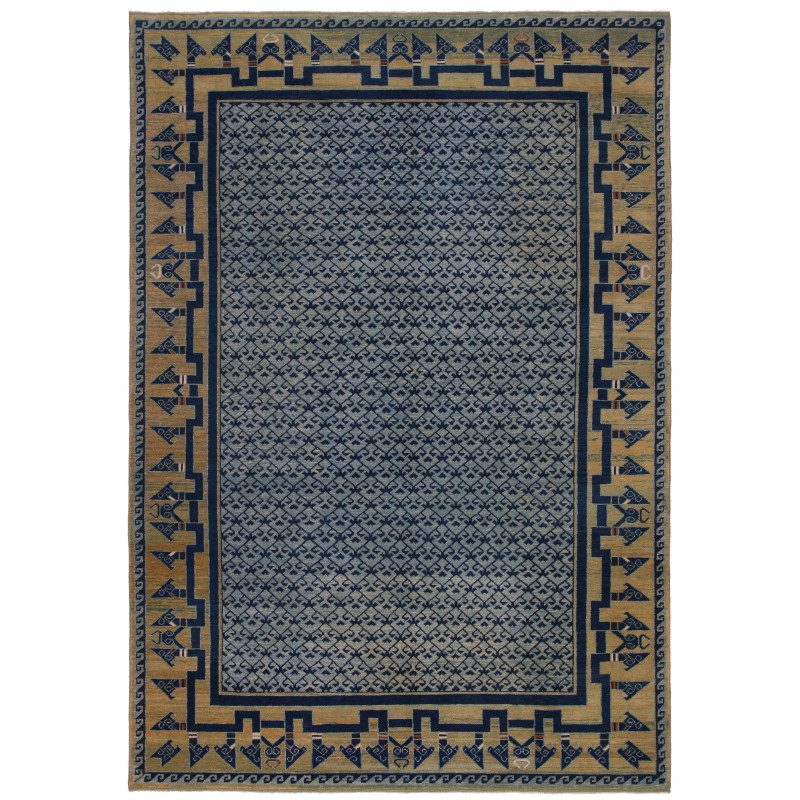
- Stock: In Stock
- Model: C50389
- サイズ: 288cm x 204cm
- SKU: ART389
この絨毯の情報は、Michael Fransesの著書『Orient Stars Collection, Anatolian Tribal Rugs 1050-1750』(Hali Publications Ltd、2021年、図版21)から来ています。この13世紀の絨毯はおそらくアナトリア中央部のコンヤ地域、紀元前1200年から1300年頃(C 1290-1420)のものです。この絨毯はイスタンブールのトルコ・イスラム芸術博物館で展示されています。セルジューク朝の時代は、アナトリアの美術と建築の最高潮の一つを記録しており、この時代のトルコの結び目の絨毯の発見には非常に大きな興奮が引き起こされました。1905年、フレドリック・ロバート・マーティン(1868-1933)がコンヤのアラッディンモスクで7つの例を発見しました。アラッディンモスクは、12世紀半ばから13世紀半ばにかけて段階的に建設されたスルタン国の中心部に位置する最も重要なモスクです。一般的に「セルジューク」または「アーリーコンヤ」絨毯と呼ばれています(ただし、これらは後のコンヤに帰される絨毯とは関連していません)。これらは早くも初期のアナトリアの絨毯の中で最も重要なグループとされるようになりました。彼らのパターンは建築に反映されず、セルジューク朝の宮廷の芸術を表現しているわけではありません。むしろ、当時中央アナトリアに住んでいた遊牧民族または半遊牧民族のトルコ人部族の作品である可能性が高いです。したがって、「セルジューク時代」というラベルがより正確です。4つは大きくて完全ではなく、他の3つは断片的です。これらは1911年にイスタンブールのエフカフ博物館に移され、その後トルコ・イスラム芸術博物館に移されました。
1908年に彼が3つをカラーで出版した際、マーティンは次のように書きました。「トルコで最も美しく最も古いモスクの一つである1220年に完成したアラッディンモスクには、4つの絨毯と2つの断片があります。数百枚の絨毯で床を覆っていますが、これらは他のすべての絨毯とは異なる特徴を持つ、同じ種類で同じ時代のものです。彼らの地は非常に単純なパターンで繰り返されています。特徴的なボーダーはクーフィック装飾文字から成り、その華麗な形状と大きさによって、他の絨毯に見られるような文字とはまったく異なります。これらはカリフの開始時に使用されていた壮大なクーフィック文字の子孫です」。私たちのデザイナーは、この絨毯に合う柔らかな色を選びました。
The source of the carpet comes from the book Orient Stars Collection, Anatolian Tribal Rugs 1050-1750, Michael Franses, Hali Publications Ltd, 2021 fig.21. This 13th-century carpet is from probably the Konya region, central Anatolia, circa 1200-1300 (C 1290-1420). It is exhibited at the Museum of Turkish and Islamic Arts, Istanbul. The Seljuk period marks one of the highest points in art and architecture in carpets Anatolia. It is therefore not surprising that tremendous excitement was caused by the discovery of two groups of Turkish knotted-pile carpets from this era. In 1905 seven examples were found by Fredrik Robert Martin (1868-1933) in the Ala’eddin Mosque in Konya, the foremost mosque at the heart of the Sultanate, which was constructed in stages between the mid-12th and mid-13th centuries. Generally referred to as the ‘Seljuk’ or ‘Early Konya’ carpets (although they do not relate to any later carpets that are attributed to Konya), these soon came to be considered the most important group of early Anatolian carpets. Their patterns are not reflected in the architecture and do not represent the art of the Seljuk court; they are more likely the work of one of the nomadic or semi-nomadic Turkmen tribes that inhabited central Anatolia at this time. Labeling them ‘Seljuk-period’ would therefore be more accurate. Four are large but incomplete, the other three are fragmented. They were transferred to the Evkaf Museum in Istanbul in 1911, and then to the Museum of Turkish and Islamic Arts.
In 1908, when he published three of them in color, Martin wrote: ‘In Ala-al-din’s ( Ala’eddin ) Mosque in Konya, which was finished in 1220 AD, are four carpets and two fragments that differ from all others which to the number of several hundred covers the floor of this mosque, one of the most beautiful and most ancient in Turkey. Though in many ways differing, they are nevertheless all of the same kind, and from the same period, viz. contemporaneous with the erection of the mosque. Their ground is decorated with a very simple pattern repeated many times. The border of these carpets, which is their characteristic feature, consists of Kufic decorative letters, which by their pompous form and large size are entirely different from all such letters known on other carpets. They are scions of the magnificent Kufic writing that was in use at the commencement of the Caliphate’. Our designers choose soft colors for this rug.
全部で7色使っています。主な4色は以下です。
- Turquoise 330 (トウダイグサ - 茜 - 藍 - クルミの殻)
- Gunmetal Blue 409 (藍)
- Emerald Green 407 (カモミール - 藍)
- Emerald Green 407 (カモミール - 藍)
上の番号は私たちのカラーコードです。()の中は、主な草木染めの材料です。
